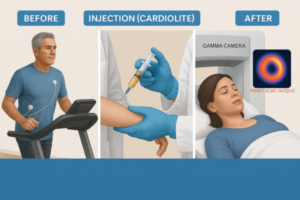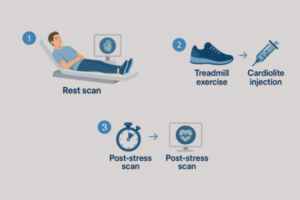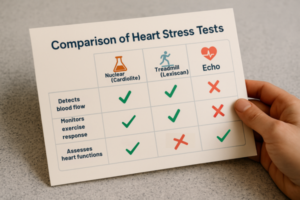Cardiolite Treadmill Stress Test: What It Is & Why You Shouldn’t Ignore It
In case you have ever felt tired, had chest pains, or felt out of breath when exercising and there was no known cause, a Cardiolite treadmill stress test may be the answer, or key to sort out your heart health. This radiology test is a non-invasive procedure that includes physical activity along with nuclear imaging to estimate blood flow to the heart, and it identifies any areas of problem even before it become severe. It is usually recommended when individuals are at risk of developing coronary artery disease but also to people who just need to make sure that their cardiovascular system is working well.
In this article, we’ll guide you through everything you need to know, including who it helps, how it works, and what makes it so powerful.
Signs You Should Never Ignore — Is Your Heart Trying to Warn You?
Even without a formal diagnosis, your body often tries to send you quiet signals that something’s wrong — especially your heart. The Cardiolite Treadmill Stress Test helps catch these signs before they become life-threatening.
Here are the key signs you should never ignore:
✅ Unexplained Fatigue
You feel tired or drained even after minimal physical activity.
✅ Chest Pain or Tightness
A squeezing, heavy, or uncomfortable feeling in your chest — especially during exertion.
✅ Shortness of Breath
You’re finding it harder to breathe during walking, climbing stairs, or light workouts.
✅ Dizziness or Lightheadedness
It may include feeling lightheaded or dizzy, especially during activity, as one of the signs of blood flow disorders.
✅ Irregular or Rapid Heartbeats
You feel your heart containing skipped beats, putting up a rush, or pounding stronger than usual.
✅ Anxious Feelings About Your Health
Constant worry, Googling symptoms, or feeling that “something isn’t right” — your instincts matter.
🟨 Important Reminder: These symptoms can appear mild at first and are often brushed off as stress or aging. But ignoring them could mean missing early detection of a serious heart condition.
🎯 The Cardiolite Treadmill Stress Test is designed to catch what your symptoms are hinting at — even if basic tests miss it.
Who Should Read This? (User Personas That Match You)
- 👓 The Health-Minded Senior
You are self-starters in terms of your health. You are taking periodic checkups and you do not want your heart to be weak when you grow old. You don’t wait for symptoms, you believe in prevention. - 💼 The Busy Professional
Work, meetings, deadlines – your schedule is packed. But lately, you’ve noticed you get winded easily. A Cardiolite treadmill stress test can provide peace of mind or early detection. - 🏃♀️ The Fitness Enthusiast
You are a lively person and sometimes you may become short of breath or some degree of chest discomfort. This test helps you see if your heart is keeping up with your energy. - 🧠 The Anxious Researcher
You’ve Googled symptoms a hundred times and still feel uneasy. This test could finally give you the clarity and reassurance you need.
What Is a Cardiolite Treadmill Stress Test?
A Cardiolite treadmill stress test refers to a nuclear imaging method of testing or measuring the flow of blood to the heart when subjected to exercise. The radioactive tracer injected into your blood is called cardiolite (technetium-99m sestamibi). This tracer allows special cameras to capture images of your heart while it’s under stress and at rest.

This test is commonly used:
- In order to diagnose the coronary artery disease
- In order to assess chest pain or dysnoea
- To monitor heart function after treatment
- Before surgery or major procedures
How the Cardiolite Stress Test Works – Step-by-Step
Preparation Before the Test
- Do not take any food or drink 4-6 hours before the test
- Caffeine and smoking should be avoided
- Wear comfortable clothes and walking shoes
- Inform your doctor about all medications you take before
During the Test
- Resting Scan: You’ll receive a small injection of Cardiolite. A resting scan is completed after 20-30 minutes.
- Treadmill Exercise: You will walk on a treadmill while your blood pressure and heart rate are observed.
- Stress Imaging: At peak exercise, a second injection of Cardiolite is conducted. You continue walking for a few minutes.
- Post-Exercise Scan: You will rest again and get the second scan to see a difference between the scan of your heart at rest and during stressful factors.

Expert Insight: Why Cardiologists Trust This Test
“This test allows us to detect reduced blood flow to the heart with high accuracy, often before symptoms even become severe.” — Dr. Sofia Malik, Cardiovascular Imaging Specialist
Cardiologists rely on the Cardiolite treadmill stress test because it gives both functional and anatomical insights. The availability of nuclear imaging has an added advantage of giving a graphical representation of how the heart is working under physical stress and in this way, it is easy to identify the early stages of the disease.
My Personal Experience With the Test
I am the person who experienced fatigue and occasional tightness during exercise; hence, my doctor suggested a Cardiolite treadmill stress test. I was nervous about the procedure, but found it to be simple and surprisingly comfortable.
The detail was impressive and memorable. The staff clarified everything, and I never had the feeling of what was coming next. The treadmill was not any different as what I have been doing in the old times as warm-ups, but I was aware it could reveal silent heart issues, made it far more significant.
It was a relief and source of power to view my results. I now better understood the nature of my heart and it made me make better choices regarding my health.
5 Differentiating Features of the Cardiolite Stress Test
- Dual-Layer Diagnostic Power: Combines physical exercise with advanced imaging.
- Non-Invasive: No sedation or surgery, as well as little discomfort.
- High Sensitivity: It will indicate low circulation even before a person realizes it.
- Highly Reliable: Heart doctors all over the world have trusted it over many decades.
- More Precise Than ECG: Can give a highly detailed picture of more than a standard ECG or echo stress test.
Cardiolite vs. Other Heart Stress Tests: What’s the Difference?
| Feature | Cardiolite Treadmill Test | Lexiscan | Echo Stress Test |
|---|---|---|---|
| Exercise Required | ✅ Yes | ❌ No | ✅ Yes |
| Uses Tracer | ✅ Yes | ✅ Yes | ❌ No |
| Detail Level | ⭐⭐⭐⭐⭐ | ⭐⭐⭐⭐ | ⭐⭐ |
| Ideal For | Active or moderate-risk patients | Those unable to exercise | Structural assessment |
| Imaging Type | Nuclear | Nuclear | Ultrasound |
What Does It Cost? (Price Range & Value)
The prices of a Cardiolite treadmill stress test also differ according to the type of healthcare provider, the condition of insurance, and location area. Its average cost is between $800-$1500 dollars. Many facilities offer financial assistance or installment plans.
Pros & Cons: The Honest Review
✅ Pros:
- Early detection leads to proactive treatment
- Quality imaging/diagnosis
- Non-invasive and in most cases well tolerated
❌ Cons:
- Involves a small amount of radiation
- Not suitable for people with severe mobility issues
- Can cause mild anxiety due to treadmill exercise
Real People, Real Benefits (Wao Factor!)
The Cardiolite treadmill stress test can uncover these silent threats before they lead to heart attacks. This is the reason why heart doctors usually say: “This test may easily save your life, of which you did not know you were already ill.”
Frequently Asked Questions
Q1. Is the radiation dangerous?
A: No. There is not much radiation as in a normal X-ray.
Q2. Will the test hurt?
A: Not at all. The treadmill may make you feel tired, but the injections and scans are painless.
Q3. Can I drive home afterward?
A: Yes. Most patients resume normal activities after the test.
Q4. What if I can’t walk well?
A: In such cases, a pharmacological alternative such as “Lexiscan” may be used to copy exercise.
Q5. Do I need to fast before the test?
A: Yes. In most cases, a 4-6-hour fasting is necessary prior to the test to yield accurate results.
Conclusion: What should you do? Get the Cardiolite Treadmill Test?
The Cardiolite treadmill stress test is a diagnostic test that is a good option for you, if you are suffering from unexplained fatigue, chest pain, or you are simply someone who cares about better preventive health. It combines exercise with imaging to detect heart problems early, often before symptoms appear.
Disclosure
This is an informational article only. It does not replace professional medical advice. Before making health choices and taking diagnostic tests, first consult your healthcare provider.
References
- HealthyHeartInfo.org: “Understanding Nuclear Cardiac Testing” [Independent Medical Resource]
- CardioInsight.net: “Comparing Stress Tests: Echo vs. Nuclear Imaging”
- MedScanDirect: “Outpatient Imaging Trends 2023”

